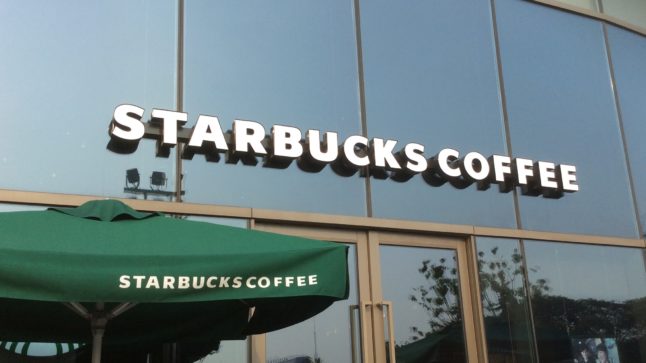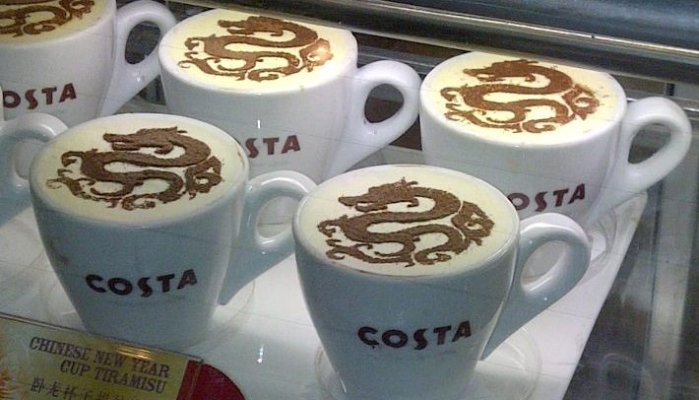Multinationals and entrepreneurs come to China dreaming of 1.3B consumers. But what they actually encounter is a sea of ruthless competitors and pervasive political challenges and complications. It’s a ferocious market and most fail. A rare few fight their way through, ultimately arriving bloodied at a certain level of success, or at least a viable market share.
And then there’s Starbucks, which is having tremendous success in China and doing so in a surprisingly pain-free way. It hasn’t faced significant regulation. It hasn’t faced significant competition from a state-backed entity or other. In fact, after 18 years in China, it still does not have a serious competitor in the Mainland. That’s pretty unprecedented and very strange. More on this unusual situation below, but first some background on my long and obsessive history with Starbucks China.
My area of research is rising Chinese consumers (and digital China), which are as big an economic phenomenon as you will find anywhere. But I don’t focus on the demographics of this group. Instead, I focus on the competition for them. I study the fights, such as the experiences of multinationals like Apple, Coca Cola, Walmart, KFC and Uber in China. And the experiences of dominant Chinese companies like Tencent, Haier and and Lenovo. My interest is the competitive dynamics and what it takes to win the fight for rising Chinese consumers. This mostly means looking at a shifting dynamic between three forces: consumer behavior, competitive dynamics and state involvement.
I am also a huge Starbucks fan. Most of my four books and +150 articles have been written in various Starbucks around the world. I can tell you in great detail where the best Starbucks are in China (the 24-hour outlet in the Kerry Center Beijing is a favorite), which New York outlets usually have available seating (forget midtown) and why the Starbucks in Saudi Arabia used to have a different logo (a palm tree instead of a woman). Although I have never quite understood why the ones in Rio de Janeiro always open 20 minutes late, which annoys me to no end.
But I figure my competitive research plus my Starbucks addiction somewhat qualifies me to write about how Starbucks won in China. It’s something I have been following for about a decade. My take is basically five points.
Point 1: Starbucks got to China early and committed for the long-term.
Winning in emerging markets usually requires committing to a market before it has actually emerged. If you wait for proven demand, you are usually too late. Starbucks got to China in 1999, long before Chinese could afford to buy premium retail coffee. And while it was clear that Chinese would one day buy cars and homes, it wasn’t clear back then that they would buy expensive coffee. But Starbucks arrived early and made a long-term commitment to a still emerging market.
CEO Howard Schultz has said the company lost money for nine consecutive years in China. And for most of their 18 years, they priced their drinks way above what the vast majority of Chinese consumers could or would pay. It was a very long-term strategy. They basically staked out a position as a highly branded, “affordable luxury” product and then waited for rising Chinese consumers to finally ascend to the middle class.
That was really a great approach. Per Berkshire Hathaway Vice-Chairman Charlie Munger, most great businesses (as well as great countries and individuals) engage in this sort of “pain now” for “gain tomorrow” approach. Or to quote his partner Warren Buffett, “someone is sitting in the shade today because someone planted a tree long ago.” Starbucks got to China early, committed for the long-term and endured a decent amount of pain for its success today. 前人栽树,后人乘凉
Point 2: They got the high traffic and high visibility locations – and Chinese eventually took to their “3rd location” concept.
There isn’t much loyalty in coffee. I like Starbucks but if a Costa is across the street and Starbucks is four blocks away, I’m probably going to Costa. Getting the high-traffic and high-visibility locations is critical. This presents a particular problem because Chinese real estate is a world of complexity unto itself. Yet today, you cannot go to any first or second-tier Chinese city and not see Starbucks in literally all the best locations. Not just some of them. It seems like all of them. It also must drive their competitors crazy.
This real estate aspect is particularly important in China, as most customers don’t own cars and the retail coffee market thus far has tended to be a lot about the experience. People are not grabbing a coffee on the way to work, like in Manhattan. That happens but they are more sitting and chatting with friends. They are holding meetings. It is more about the experience in China at this point. Chinese consumers appear to have taken to the idea of a coffee house as a “3rd location” in their lives. And as the cities continue to urbanize (China adds a Japan-sized population to its cities every eight years), this “3rd location” phenomenon should continue to grow.
Point 3: Starbucks is now making the right moves with regards to growth, localization and digitization.
Starbucks’ current growth plans for China have been widely reported and repeated. They have 2,600+ outlets and are opening an average of one per day. They plan to open 500 a year until they reach about 5,000. Personally, I think this is pretty slow. Five thousand stores isn’t that many for China. As explained below, I think Starbucks should go faster. But they don’t ask my opinion.
What is more interesting than their growth plans are the company’s activities in localization and digitization. Store renovations mean their China outlets are starting to look like modern versions of traditional Chinese tea houses. The stylistic elements, such as traditional wooden Chinese furniture and wall hangings, can be stunning and make them fantastic places to hang out. Ironically, it is a coffee company that is reviving and reinventing the traditional Chinese tea houses. These efforts at localization, a blending of Starbucks style with Chinese history and culture, are important. Study after study shows that Chinese consumers buy more when companies incorporate Chinese history into their business.
The other activity to watch is the company’s digital initiatives. China is now the world’s epicenter for mobile innovation, from smart phones, to mobile payments, to deliveries and so on. For Starbucks and other Chinese retail outlets, the simplest versions of digital initiatives usually involve mobile ordering, payments and social gifting. But this is just the beginning. The more interesting efforts are those in social media that are attempting to increase customer engagement and loyalty. And ultimately, there is the question of whether digital tools can “personalize” Starbucks for each individual customer. That is fascinating and is part of the “new retail” that companies like Alibaba are talking about. The person I am paying the most attention to at Starbucks is not CEO Howard Schultz; it is Molly Liu, the Starbucks China Digital Vice President.
Point 4: The absence of a serious China competitor is very strange.
Ok. Back to the main point, which is that the mostly painless experience Starbucks has had in China is very strange.
Most of the above points could be made about many well-run multinationals in China (Nike, Walmart, Coca-Cola, KFC). Yes, Starbucks made all the right moves in China, but so did lots of other companies. What is strange about Starbucks is it does not have a serious competitor in China. Wanda is fighting Disney to be the “Disney of China.” Baidu has become the “Google of China.” Wal-Mart is fighting Carrefour, Suning and others. Nike fights Li-Ning and Anta every day. Uber just had a $2B money war with Didi (and then left the field). And so on. Yet you can’t point to a single, big well-run competitor for Starbucks in China. There is no significant “Starbucks of China”.
In practice, this means there is no major Chinese company (private or SOE) that is pummeling them with advertising or pushing up prices on the best locations. There is no 5,000+ outlet retail chain planning to run at a loss for the next five years just to get market share. And even their foreign rivals, such as Costa Coffee and Pacific Coffee, are pretty small in China. I still don’t have a clear explanation for why this is happening.
Looking at private sector success stories in China, such as KFC, Alibaba and Nike, what you tend to see are hardened management teams that have been bloodied but have survived. They are the teams that fought their way to the top against competitor after competitor. It is one of the reasons why China CEOs such as Jack Ma are so formidable in their current international expansions. The victors of China’s domestic markets tend to be a ferociously competitive group.
Final Point: Starbucks’ biggest risks going forward are changing consumers and somewhat untested management.
I do worry about two things for Starbucks in China going forward. The first is that Chinese consumers will lose interest (somewhat) in coffee or in Starbucks. This is a fickle consumer group. Popular companies do fade in China all the time. It is entirely possible that some of what we are seeing is a fad to some degree, and that going to Starbucks with your friends will not be as cool in a couple of years. Starbucks will have to keep adapting.
The second is that the management team has just had it too easy. They haven’t faced a long-term assault from a well-funded, well-run, politically connected competitor. Keep in mind, most of the food companies that are successful in China today, from beer to oranges, are state-owned enterprises. If any of these massive conglomerates, say China Resources, sets their sights on retail coffee, it would be a real threat for Starbucks China.
***
My unsolicited recommendation would to be to grow a lot faster. Howard Schultz recently said China is Starbucks’ most profitable market at the store level. And that he thinks it could one day be their largest market globally. That is amazing but it has been very unusual for them to have such uncontested success in China. I would assume this will not last. They should run as fast as they can while it does.
Thanks for reading, -jeff
A couple of background points:
- While Starbucks now owns most of its stores in China, the company used partners to help establish itself on the mainland.
- In northern China, the company had a licensing agreement with Beijing Mei Da Coffee Co. Ltd, which Starbucks purchased in 2006.
- In southern China and a few other provinces including Sichuan, Shaanxi and Hubei, the company linked up with Hong Kong food conglomerate Maxim’s Caterers, before buying full ownership of those stores in 2011.
- In Shanghai, Jiangsu and Zhejiang, Starbucks continues to partner with Taiwan-based food company President Chain Store Corporation, a unit of Uni-President Enterprises.
Reposted from AmCham Shanghai (link here)
——-
I write, speak and consult about how to win (and not lose) in digital strategy and transformation.
I am the founder of TechMoat Consulting, a boutique consulting firm that helps retailers, brands, and technology companies exploit digital change to grow faster, innovate better and build digital moats. Get in touch here.
My book series Moats and Marathons is one-of-a-kind framework for building and measuring competitive advantages in digital businesses.
Note: This content (articles, podcasts, website info) is not investment advice. The information and opinions from me and any guests may be incorrect. The numbers and information may be wrong. The views expressed may no longer be relevant or accurate. Investing is risky. Do your own research.
Photos by Jeff

